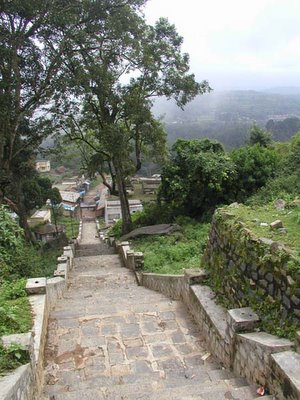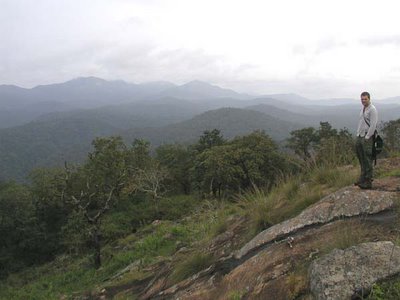Adventures in field ecology...plants, creatures, cultures, and the mad biological alchemy that keeps the world spinning.
24 February 2006
te-rain
OK some play by play Indian madness...Rolled into Gokarna on the west coast this evening after a crazy mad stressful travel day. Overnight train into Mangalore then the afternoon local express heading up the coast. Getting on the carriage in this bottleneck press of sweaty small Indian torsoes and limbs, my mandolin case handle broke and reaching down to grab it, my glasses got knocked off and down into the abyss below the platform as the press of bodies lurched up and forwards. Scrambling back upright to establish my presence I try to step up and someone has my slipper pinned to the step so I stumble on the train figuring its gone as well. Somehow it stayed on the step and after searching along (and underneath) the train carriage I ended up jumping off to wait for the train to leave to get my lenses. My friend stayed on with a ticket for two and I figured I'd just take a miserable 6 hour bus ride up...but I got a harrowing turbo rickshaw ride (oncoming traffic? what oncoming traffic?) and caught the train at the next stop....now safe and sound near the beach in Gokarna awaiting a supposedly unreal Hindu festival to start on the new moon.
11 January 2006
Trying to catch up
 The last (and only) email I sent out to friends and family was pictures from town...the mad mad city life in India. So now is the time to show a bit of the Biligiri Ranganaswami Temple Wildlife Reserve, or the BR Hills for short, about 80 km SW of Mysore, in the state of Karnataka, where I've been spending the majority of my time.
The last (and only) email I sent out to friends and family was pictures from town...the mad mad city life in India. So now is the time to show a bit of the Biligiri Ranganaswami Temple Wildlife Reserve, or the BR Hills for short, about 80 km SW of Mysore, in the state of Karnataka, where I've been spending the majority of my time.When I say I'm working in the forests of southern India, most would envision a hot and humid jungle. (As a biologist, I have to state that while the word "jungle" does get the imagination firing, science has long abandoned it for terms like "rain forest" or "humid tropical forest"). Actually, where I'm working much of the forest is nothing like the "jungle" one would tend to picture.
(dry deciduous forest)

The forests of the BR Hills look closer to temperate woodlands than anywhere else I've worked in the tropics. And it feels like a temperate forest...more open and dry with lots of deer and elk...that is until you come across a herd of gaur (Indian Bison) or elephants in the woods or spot fresh tiger tracks in the mud.
(Indian bison-came across it injured one day near our study site...
the next day it had died)
the next day it had died)
 Its really the elephants that we have to worry about. I've wandered near bison herds, seen a leopard close by and listened to a tiger attacking a gaur a 100 meters off in the woods. But one of the problems in the BR Hills is the invasive weed, Lantana camara, which grows in huge thickets in many parts of the reserve. Beyond halting regeneration of forest trees, it makes it very difficult to spot wildlife until you are right on top of them, or in the case of elephants, right underneath them.
Its really the elephants that we have to worry about. I've wandered near bison herds, seen a leopard close by and listened to a tiger attacking a gaur a 100 meters off in the woods. But one of the problems in the BR Hills is the invasive weed, Lantana camara, which grows in huge thickets in many parts of the reserve. Beyond halting regeneration of forest trees, it makes it very difficult to spot wildlife until you are right on top of them, or in the case of elephants, right underneath them.(steps leading down from the temple)

But its not all wilderness and encounters with birds and beasts. There's an old Hindu temple built on a hilltop near the field station (hence the name of the reserve) so plenty of people from the surrounding towns come to visit. Even within reserve itself little podus (villages) of the local indigenous people, the Soligas, dot the hillsides. The contrast between here and the cities...the cleanliness, the pace of life, and the beauty of the landscape...is pretty stark. All in all I try to make the trek down to Mysore or Bangalore as little as possible.
More to come soon...
(~5000 ft. elevation...the BR Hills!)

Subscribe to:
Comments (Atom)